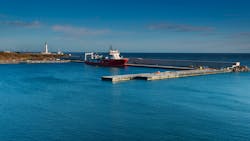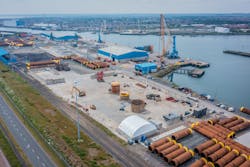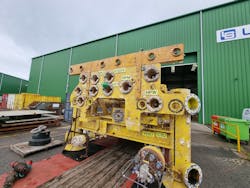UK ports, contractors respond to surge in North Sea decommissioning
Editor's note: This story first appeared in the November-December 2022 issue of Offshore magazine. Click here to view the full issue.
BY JEREMY BECKMAN, EDITOR, EUROPE
According to market forecasts, the UK North Sea looks set to lead global offshore decommissioning activity through the end of this decade. But the final destinations for the giant platforms installed during the 1970s to 90s are often specialist dismantling sites in Norway and the Netherlands. One recent example was the topsides for Fairfield Energy’s Dunlin Alpha platform, originally built for Shell in the 1970s, which Heerema’s Sleipnir removed in June and then delivered to AF Offshore Decom’s Environmental Base Vats in southern Norway for recycling.
In part this may be down to location: many UK fields in the northern and central North Sea are closer to Norway than the UK mainland. The Shetland Islands are relatively close to the most northerly UK fields, and Lerwick Port Authority in Shetlands, with its natural deepwater setting, is equipped to handle large-scale decommissioning projects. Lerwick Harbour has two licensed decommissioning facilities, one of which, Dales Voe, took delivery earlier this year of CNR’s 8,500-metric ton Ninian Northern platform jacket from Allseas’ Pioneering Spirit.
Now various decommissioning/recycling specialists on the eastern side of Britain serving a wide range of sectors are increasingly pursuing offshore work, with two companies investing in purpose-built sites in Aberdeen and Blyth in northeast England. Another company in eastern Scotland is focused exclusively on the subsea market, cleaning and repurposing recovered subsea equipment, where possible, for re-use in other projects.
ABERDEEN WATERFRONT EXPANSION
Port of Aberdeen (formerly Aberdeen Harbour) is developing what it claims is the UK’s largest current marine infrastructure project. The city’s £400-million ($464-million) South Harbour expansion is designed to offer new business opportunities to clients through the addition of deeper water quays able to accommodate larger vessels, and more extensive laydown and heavy-lift areas. In July, Subsea 7’s DSV Seven Atlantic became the first vessel to berth alongside the newly opened Dunnotar Quay, with Crathes and Castlegate (East) Quays also becoming operational early last month. Two more quays should enter service during December and next spring, making Aberdeen Scotland’s largest berthage port.
The development was needed because of capacity constraints at the existing North Harbour, due to its location in the city center. When fully operational, South Harbour will provide 1.4 km of new deepwater berthage (400 m at a depth of 10.5 m LAT and 1 km at a depth of 9 m LAT); heavy-lift zones accommodating loads of up to 15 metric tons/sq m; and 125,000 sq m of laydown area. One of the targeted sectors is dismantling and recycling of decommissioned offshore oil and gas structures, complementing the North Harbour’s existing capabilities.
North Harbour can accommodate well P&A vessels loading up with commodities such as cement, or returning from the offshore location to offload cutting/handling equipment. It also provides recycling of retrieved subsea structures such as pipelines and concrete mattresses, and removal of buoyancy support structures from floating production vessels. Its track record includes supporting the decommissioning campaign for the James, Janice, Affleck and Leadon fields in the central UK North Sea, and taking delivery of two subsea mid water arches weighing around 100 metric tons each, along with three towheads. It can accommodate `piece small’ topside structures, however `piece large’ structures requiring further quayside handling and cutting would typically be handled at South Harbour.
One of the first clients to commit to the expanded South Harbour site is CessCon Decom, which provides a full decommissioning scope ranging from initial studies and surveys, to offshore asset removal and onshore dismantlement and recycling, with a special focus on project-tailored `Engineering Down’ and cleaning solutions. Recently CessCon Decom laid the ground for a new decommissioning hub at Crathes Qay that will provide dismantling, recycling and re-use services with a focus on subsea structures. This is the company’s second major investment on Scotland’s east coast after its Energy Park Fife complex in Methil, north of Edinburgh, where the main current offshore dismantlement program involves re-use and recycling of Spirit Energy’s decommissioned DP3 and DP4 platforms, two of the original structures built for the Morecambe Bay gas development in the East Irish Sea.
According to the company, the Fife facility houses one of the UK’s most advanced decommissioning centers, providing access to 165 m of quayside (up to 8.2m water depth) and up to 30,000 sq m of hard standing laydown area. The dismantlement and processing area has a purpose-built membrane layer incorporated into the concrete slab, with a water collection and treatment system that separates and treats fluids in the offshore structure before discharging the non-contaminated fluids back to the sea.
CessCon sees the UK decommissioning market in particular as “huge”, according to Chief Executive Lee Hanlon, and is working with the Port to establish Aberdeen as an offshore decommissioning center capable of handling turnkey projects. The new hub, which will become operational in January 2023, will feature heavy-lift zones, impermeable concrete dismantlement and processing areas, water collection and treatment facilities, materials storage areas, and offices. One of the attractions for the company was South Harbour’s capability to accommodate heavy-lift and transport vessels up to 300 m long. However, Cesscon will likely direct future work for large North Sea platforms to Fife, reserving the Aberdeen hub for smaller sized structures.
BLYTH DEVELOPMENT
At the port of Blyth in northeast England, Heerema Marine Contractors is due to deliver six platform structures next summer from decommissioned gas fields in the UK southern North Sea, operated by Spirit Energy. Two large barges will carry the structures to the Battleship Wharf Terminal: on arrival, Thompsons of Prudhoe, working in partnership with the Port of Blyth and Mammoet, will oversee offloading and subsequent transportation on SPMTs (special purpose mobile trailers) to Thompsons’ purpose-built decommissioning area.
DeepOcean will recover the field’s subsea structures, flexibles, rigid pipelines, umbilicals, and concrete mattresses and deliver them to the Port on various vessels. Thompsons – a specialist, family-owned demolition, deconstruction and decommissioning business formed in 1948 – will be responsible for the dismantlement, recycling and where possible re-use of Spirit’s entire package.
Battleship Wharf Terminal will receive three topsides and three jackets from the Audrey A and B and Ensign platforms with a total weight of around 6,500-7,000 metric tons. Spirit has identified further southern North Sea platforms still in operation at the Chiswick, Grove and York fields for an optional scope during 2024-29.
During 2019-20 Thompsons undertook for Spirit Energy the full demolition and dismantling of its South Morecambe onshore gas terminal in Barrow, Cumbria, which received production from the Morecambe Bay fields in the East Irish Sea. In 2019 the company had also been actively tendering on the current (southern North Sea) project, worked closely with Subsea 7 to develop an onshore solution for the A-Field platforms before the project was postponed and re-tendered in 2020.
Thompsons has performed various subsea structure dismantling projects over the last few years including a 516-metric ton floating tidal turbine for Orbital Marine & Power that Mammoet had transferred to the Blyth quayside using crawler cranes, the port’s heaviest lift to date. It has also disposed of UK North Sea tether bases (via ASCO) for EnQuest, subsea ploughs for DeepOcean, and subsea anchors for Harbour Energy, via Boskalis The company and Port of Blyth have formed a long-term partnership to jointly develop solutions for decommissioned offshore structures from initial tender enquiry to project completion. They have jointly invested £1 million ($1.16 million) in enhancements to the 2.3-ha facility, such as oil interceptors, storage tanks, and reinforced impermeable concrete surfaces. Thompsons committed a further £250,000 ($290,000) for construction of a NORM (Naturally Occurring Radioactive Material) treatment facility on site, which removes the need to send recovered offshore oil and gas materials for cleaning to specialist companies elsewhere.
“The partnership offers a unique project service and turnkey solution that removes the need for using haulage while offloading/transporting cargo to the decom facility,” a spokesman explained, “also providing 24-hr operations and recycling solutions for concrete mattresses. Thompsons are demolition and decommissioning specialists operating across all industry sectors, including work on live operations sites. Safety is paramount and these procedures are embedded into the company’s Safe System of Work and operational procedures. This knowledge, experience and capability is being transferred to execution of decommissioned offshore facilities works.”
Recent bottlenecks in materials supply worldwide briefly led to increased demand for the cleaned-up scrap metal from dismantled offshore platforms. “But the market has since settled back to ‘normal’ levels,” the spokesman said, “and is expected to stay the same for the next six-12 months. As for the subsea structures from Spirit’s fields, these will be dismantled, decommissioned and recycled. Items identified for re-use will be sold, with the remainder recycled where reasonably practicable. We expect to achieve a >97% recycling rate on this project.”
Despite the growing competition in the UK, Thompsons believes the North Sea market “remains big enough to ensure that all UK disposal yards will have a sustainable/manageable throughput year on year. With rising vessel and fuel costs, the geographical locations of the fields being decommissioned will play a huge part in the selection of disposal yards.”
A specialist UK contractor with over 30 years’ experience in disposing of platforms for offshore operators is Able UK. The Able Seaton Port, a short distance down the English east coast on Teesside, received three redundant gas platforms weighing a combined 12,879 t for dismantling in August, all delivered by Heerema Marine Contractors from the decommissioned Murdoch field in the southern North Sea. After these had undergone partial dismantling at sea, barges took the structures to the port’s heavy duty quays. Able was aiming for a recycling rate of over 97% and expected further load-ins from other secured projects.
SUBSEA RECYCLING
Legasea, based outside Aberdeen, claims to offer an alternative approach to recovered subsea systems. The company, formed in 2018, is investing £1.3 million ($1.49 million) in expanding its `Shore to Store’ service, which provides refurbishment, re-certification and re-use of as many components as possible from subsea equipment no longer required by the field operator. Its complex in Echt features a 2,200 sq-m warehousing/workshop area; a 3,690-sq m yard area; 75- and 25-ton overhead cranes with a 10.6-m hook height; and a test tank with internal and external access. The new investment, which includes a grant from Scottish Enterprise, covers the added personnel, facilities and capital equipment needed to complete all planned projects through 2024. “Our longer-term aim is to expand our service offering internationally,” said Operations Director Ray Milne, “offering decommissioning support in hubs globally. There is a lot of subsea decommissioning to come in the next 30 years, not just from UK fields but across Norway (from 2030 onwards), Southeast Asia, Australia, and the Gulf of Mexico.”
The background of Legasea’s management team is primarily in subsea drilling and production, with a mixture of engineering, manufacturing and operational experience. “Having all worked for service companies,” Milne explained, “we had seen many first-hand examples of perfectly serviceable equipment being needlessly disposed of, despite demand for the same equipment. There has always been a market for reconditioning of subsea capital equipment, such as risers, wellhead connectors and running tools, but the service that we introduced was unique due to the focus on the equipment, which often operates for a prolonged period on the seabed, and is then typically disposed of following recovery.”
Since embarking on the Shore-to-Store service in 2020, Legasea has managed and completed turnaround projects on 43 redundant subsea production systems: one of its more extensive programs, completed earlier this year, involved disassembly of 10 retrieved systems from a decommissioned gasfield development in the Celtic Sea off southern Ireland. “The condition of the equipment that we handle has varied,” Milne said, “depending on duration on the seabed, the effectiveness of the sacrificial anodes, and the level of marine growth present. Throughout each of these projects, we have cleaned the structures, and disassembled the equipment to component level. In most cases, the equipment is restored to an excellent condition, particularly stainless steel parts, which often look just like new following full refurbishment.
“More often than not we engage with offshore operators during the early stages of their decommissioning projects, with discussions on the condition of their equipment and what we can do with it at our site. These discussions can begin 18 months ahead of recovery, and will typically cover what’s on the seabed, when it was deployed, who made it, the control systems and so on. In some instances, we have received photographs or video footage of equipment in advance, but our expectations will vary depending on the duration of time that the equipment has been on the seabed. Some of the earliest subsea systems, deployed during the 1970’s and 1980’s, will have limited reuse potential for the components, due to the simplicity of the design, whereas later systems are more complex, and contain different generations of hydraulic / electric control systems.”
The more modern subsea production systems typically have very low maintenance requirements, Milne added, with many remaining in service for 30 years. Recovered systems from the 1990s can provide highly sought-after components required by other offshore maintenance crews seeking to fix an issue with another system from that era that is still in operation. Lead times for OEM replacement items can be up to six months, whereas Legasea, which often stocks the same components, can supply them within one day.
“The reception that we have received from across the industry has been phenomenal,” Milne said, “and the feedback received along the way has helped to shape our service offering. When first starting out, we knew that a large facility would be required to handle subsea trees, which are often around 40 metric tons. As a result of our combined experience with test and assembly operations, many clients have looked to us to also facilitate or manage the build and test of their new equipment prior to mobilization.”
Upon recovery during decommissioning projects, subsea structures are typically classified as waste, and are processed to ensure that all equipment for reuse is refurbished and reaches end-of-waste status. Legasea’s team performs ultrasonic cleaning on site in Echt to remove contamination from a range of surfaces, including metals, composites and alloys. The remaining fluids, marine growth, and structural steel/pipework are managed to ensure that everything is recorded and transferred to appropriate waste management contractors in accordance with duty-of-care legislation, while also ensuring that personnel and the environment are protected. When taking equipment ashore, it makes more sense to be as close to the quayside as possible, Milne noted, as the size and weight of these structures can make them tricky to transport.
“Many of the projects that we are involved in are from brownfield operations, where legacy systems are required to be maintained, using mating parts from the same era," Milne added. However, below are a few examples of projects which Milne said could be considered as new/greenfield:
- Subsea electro-hydraulic umbilicals for a UK North Sea operator: full refurbishment / flushing/testing of recovered umbilicals, which were then re-used during a new tree installation.
- Subsea electrical connectors for operators in the UK North Sea / South-East Asia: refurbishment, testing, recertification and termination, of re-used connectors, applied in the manufacture of new in-field jumpers for new subsea developments.
- Subsea gate valves – inspection and recertification of surplus valves, for use in a flowline isolation skid.
- Hydraulic couplers/stab plates for UK North Sea operators: re-use of hydraulic equipment for pre-deployment testing of new hydraulic flying leads.
- Overhaul, test and modification of a Collet-type wellhead connector for a UK operator to serve as a tree cap for installation subsea on a new well.
About the Author
Jeremy Beckman
Editor, Europe
Jeremy Beckman has been Editor Europe, Offshore since 1992. Prior to joining Offshore he was a freelance journalist for eight years, working for a variety of electronics, computing and scientific journals in the UK. He regularly writes news columns on trends and events both in the NW Europe offshore region and globally. He also writes features on developments and technology in exploration and production.




